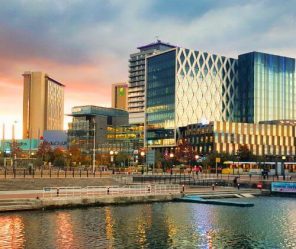The HS2 Project
The HS2 project is Britain’s new zero-carbon high-speed railway. Over 250 miles will connect London to the West Midlands and Yorkshire. Much of the construction lies on the London-Birmingham route (Phase One), seeing the creation of whole new lines and four stations. Once complete, it will link to existing routes in the North, collectively increasing property prices as the economy and population rise.
350 active sites sit between the West Midlands and London. On and off-site, the HS2 project currently supports more than 28,500 jobs and over 3,000 businesses. Over 3,000 of these employees were previously unemployed, while other roles are apprenticeships and graduate-level jobs, supporting young people on the first step in their careers.
As Phase One continues toward completion, the desire for Birmingham grows. Birmingham will see a rise in property prices due to the high-speed railway, becoming a hub of professionals choosing to relocate from London. With the HS2 project only pushing further North, the same capital growth and increase in supply, demand, and employment will be seen in Manchester and, consequently, connecting locations. Investing in the Northern Powerhouse has never been more prominent.

HS2 Completion Date
A budget of £55.7 billion for the whole HS2 project was set in 2015, with Phase One’s original target cost reaching £40.3 billion. However, in 2019, this budget spiralled to estimated costs between £72bn and £98bn.
Originally, Phase One was scheduled to be in use by the end of 2026. However, due to the construction delays, this date has been pushed back to between 2029 and 2033. Phase Two has consequently been pushed from its complete date, too. Instead of 2032, the second part of the HS2 project is estimated to be ready as late as 2040.
The HS2 phases consist of:
Phase 1: Linking London, Birmingham, and the West Midlands.
Phase 2a: Extending to Crewe.
HS2 Phase 2b: Completing the line to Manchester.
HS2 East: Linking the West and East Midlands.
Northern Powerhouse Rail: Link between Warrington and Yorkshire.

HS2 Progress
Despite being a few years behind schedule, the HS2 project is progressing nicely. From the construction of new stations to the addition of Manchester Airport and Manchester Piccadilly stops to the Crewe-Manchester extension.
The APM
The Automated People Mover (APM) is a key part of the HS2 project, and plans are to soon commence. The efficient and environmentally friendly mode of transport will carry up to 2,100 passengers per hour between HS2’s Interchange Station, the NEC, Birmingham International, and Birmingham Airport in as little as 6 minutes. Its 2.2km viaduct will run over the NEC, the M42 motorway, and West Coast Main Line.
The search for contractors to design and supply this system will begin later this year. Invites to tender will be sent in 2025 and the contract awarded in 2026. The APM will be complete in time for when Interchange Station starts its services.

Interchange Station
Interchange Station marks an economic transformation for Solihull. It is a catalyst for huge growth plans for the town, coinciding with the £3.2 billion mixed-use commercial and residential destination, Arden Cross. This alone will support up to 27,000 jobs and deliver up to 3,000 homes and 557,500m² of commercial space. However, it is all but a small part of the wider UK Central Hub area. Each year, £6.2 billion GVA will be generated and 1.3 million people will be brought to the region.
HS2’s Interchange Station is at the centre of these plans and will benefit Solihull as Curzon Street Station will Birmingham. With up to five trains estimated to pass through Interchange per hour, this key part of the HS2 project will offer approximately 175,000 seats per day and become one of the best-connected transport interchanges in the country.

Old Oak Common
The HS2 project’s new ‘super-hub’ station in West London recently marked a milestone of reaching 2 years of permanent construction. Old Oak Common has supported 1,900 jobs, welcoming 1,000 workers on-site daily.
While the HS2 project is committed to eliminating the use of diesel at its construction sites by 2029, Old Oak Common is significantly ahead of schedule and has set its own goal to be diesel-free by the end of 2024. This will be in time for the bore of the 5-mile Euston Tunnel, leading to the new HS2 Euston Station.
Old Oak Common will become a vital transport hub for the country once it opens, offering services North, South, East, and West. There are plans to transform the wider area to create tens of thousands of new jobs and homes from the former railway and industrial site.

Green Tunnels
There are five planned green tunnels on the HS2 route. They perfectly couple with the HS2 project’s sustainable goals to lower carbon emissions. The green tunnels are shallower than the conventional tunnel and are finished with trees and plants to blend them into the natural landscape. No material is wasted in these builds. What is excavated is reused on the tunnels’ surrounds to reduce waste and any movement of spoil.
Copthall Green Tunnel is the first of the five to be constructed and recently completed its western portal – a massive milestone as the 880m-long green tunnel nears completion.

Explore our Investment Guides
Take a look
As Seen In
Join CityClub Today to Receive:
- Priority access to exclusive off market investments
- Below market value pricing
- Out of hours investor support chat
- Allocated solicitor for hands free conveyancing

















